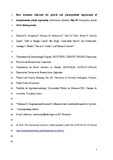Mostrar el registro sencillo del ítem
Heat treatment alleviates the growth and photosynthetic impairment of transplastomic plants expressing Leishmania infantum Hsp83-Toxoplasma gondii SAG1 fusion protein
| dc.creator | Corigliano, Mariana G. | es_ES |
| dc.creator | Albarracín, Romina M. | es_ES |
| dc.creator | Vilas, Juan M. | es_ES |
| dc.creator | Sánchez López, Edwin F. | es_ES |
| dc.creator | Bengoa Luoni, Sofía A. | es_ES |
| dc.creator | Deng, Bin | es_ES |
| dc.creator | Farrán Blanch, Inmaculada | es_ES |
| dc.creator | Veramendi Charola, Jon | es_ES |
| dc.date.accessioned | 2020-02-05T09:41:26Z | |
| dc.date.available | 2021-07-01T23:00:14Z | |
| dc.date.issued | 2019 | |
| dc.identifier.issn | 0168-9452 | |
| dc.identifier.uri | https://hdl.handle.net/2454/36195 | |
| dc.description.abstract | Previously, we showed that transplastomic tobacco plants expressing the LiHsp83-SAG1 fusion protein displayed a chlorotic phenotype and growth retardation, while plants expressing the SAG1 and GRA4 antigens alone did not. We conducted a comprehensive examination of the metabolic and photosynthetic parameters that could be affecting the normal growth of LiHsp83-SAG1 plants in order to understand the origin of these pleiotropic effects. These plants presented all photosynthetic pigments and parameters related to PSII efficiency significantly diminished. However, the expression ofCHLI, RSSU and LHCa/b genes did not show significant differences between LiHsp83-SAG1 and control plants. Total protein, starch, and soluble sugar contents were also greatly reduced in LiHsp83-SAG1 plants. Since Hsp90 s are constitutively expressed at much higher concentrations at high temperatures, we tested if the fitness of LiHsp83-SAG1 over-expressing LiHsp83 would improve after heat treatment. LiHsp83-SAG1 plants showed an important alleviation of their phenotype and an evident recovery of the PSII function. As far as we know, this is the first report where it is demonstrated that a transplastomic line performs much better at higher temperatures. Finally, we detected that LiHsp83-SAG1 protein could be binding to key photosynthesis-related proteins at 37 °C. Our results suggest that the excess of this molecular chaperone could benefit the plant in a possible heat shock and prevent the expected denaturation of proteins. However, the LiHsp83-SAG1 protein content was weakly decreased in heat-treated plants. Therefore, we cannot rule out that the alleviation observed at 37 °C may be partially due to a reduction of the levels of the recombinant protein. | en |
| dc.description.sponsorship | This work was supported by grants from the Agencia Nacional de Promoción Científica y Tecnológica of Argentina (PICT: 2014-3473, 2016-0113 and 2016-0621). This study also received institutional support from the Universidad Nacional General de SanMartín (UNSAM, Argentina). The Vermont Genetics Network Proteomics Facility is supported through NIH grant P20GM103449 from the INBRE Program of the National Institute of General Medical Sciences. | en |
| dc.format.extent | 47 p. | |
| dc.format.mimetype | application/pdf | en |
| dc.language.iso | eng | en |
| dc.publisher | Elsevier | en |
| dc.relation.ispartof | Plant Science 284 (2019) 117-126 | en |
| dc.rights | © 2019 Elsevier B.V. This manuscript version is made available under the CC-BY-NC-ND 4.0. | en |
| dc.rights.uri | http://creativecommons.org/licenses/BY-NC-ND/4.0/ | |
| dc.subject | Pleiotropic effects | en |
| dc.subject | Transplastomic plants | en |
| dc.subject | heat shock protein | en |
| dc.subject | Tobacco | en |
| dc.subject | Toxoplasma gondii | en |
| dc.title | Heat treatment alleviates the growth and photosynthetic impairment of transplastomic plants expressing Leishmania infantum Hsp83-Toxoplasma gondii SAG1 fusion protein | en |
| dc.type | info:eu-repo/semantics/article | en |
| dc.type | Artículo / Artikulua | es |
| dc.contributor.department | Agronomía, Biotecnología y Alimentación | es_ES |
| dc.contributor.department | Agronomia, Bioteknologia eta Elikadura | eu |
| dc.rights.accessRights | info:eu-repo/semantics/openAccess | en |
| dc.rights.accessRights | Acceso abierto / Sarbide irekia | es |
| dc.embargo.terms | 2021-07-01 | |
| dc.identifier.doi | 10.1016/j.plantsci.2019.04.011 | |
| dc.relation.publisherversion | https://doi.org/10.1016/j.plantsci.2019.04.011 | |
| dc.type.version | info:eu-repo/semantics/acceptedVersion | en |
| dc.type.version | Versión aceptada / Onetsi den bertsioa | es |



